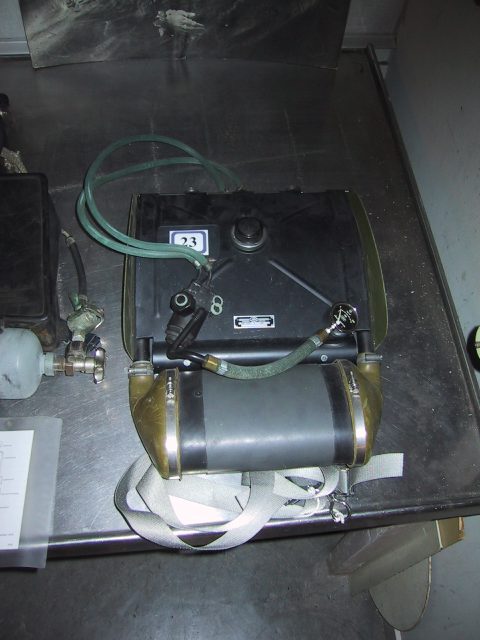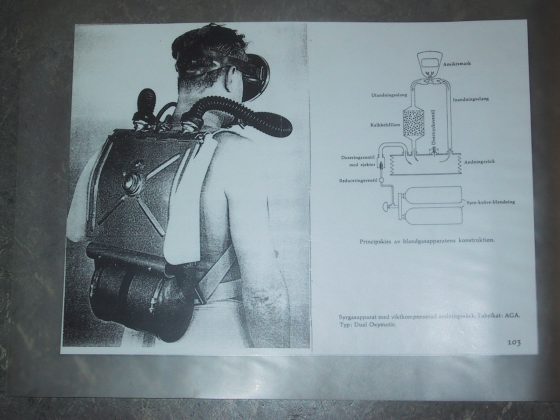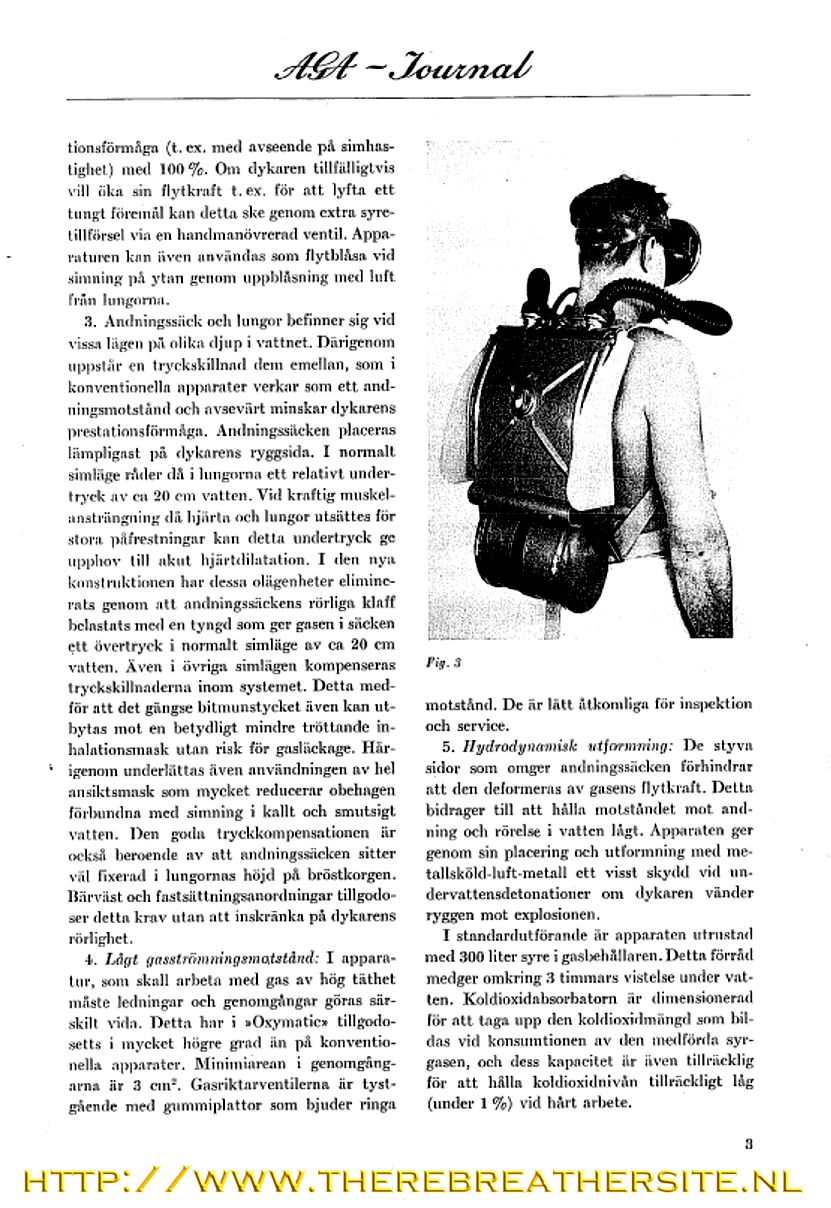 |
||||
 |
||||
| Aga Dual Oximatic photo's of
Carl E. Wern Stockholm,
Sweden, 20-02-2003
and Åke Larsson
|
||||
|
The Oxymatic is a back mounted O2 CCR. The hinged bellows is compensated for the negative hydrostatic imbalance resulting from the positioning on the back by the addition of a counter weigh, the the round bar below the number plate. The canister is an axial flow design, made of brass and is mounted in flexible rubber. The inspiratory side is to the left. |
||||
 |
||||
 |
||||
 |
||||
 |
||||
 |
||||
 |
||||
 From top:
|
||||
 |
||||
 The number plate of the 0-series AGA Dual Oxymatic, serial no 132 |
||||
 |
||||
 |
||||
 Inside the breathing bellow of the broken prototype unit the demand valve is visible. When the breathing bellows collapse the demand valve is activated, the flat plate above the spring is pressed down and thus activating the valve which opens with the pressure. The brownish tube with a chain inside seen to the right of the demand valve belongs to the dump valve, see below. |
||||
 |
||||
 The high pressure regulator with the bypass knob seen close to the white sealing washers. The tank connection (DIN O2) is located on the back side. The regulator is not ambient referenced and the adjustment is hidden under the cover to the right. Two low pressure hoses exit the regulator, one feeds the demand valve and the other one feed bypass gas into the breathing circuit. |
||||
 |
||||
 |
||||
 This is the actual prototype of this rebreather! |
||||
 |
||||
 |
||||
| Here you find the text as written on Åke Larsson's pages. All credits of this article are to mentioned people, wich I want to thank very much for this great article on a unique rebreather. You find the original pages here | ||||
| Åkes' AGA Dual Oxymatic
teardown Pictures The AGA Dual Oxymatic is a closed circuit oxygen rebreather, O2 CCR. The Oxymatix was developed in the late 1950's by the Swedish company AGA, nowadays known as Interspiro, well known for full face masks and the rebreathers DCSC and Oxydive. The rebreather was designed as a competitor to the Draeger Norge II as a possible successor to the Draeger Lt Lund II used by the combat swimmer teams in the Swedish Navy. A total number of about 50 units were manufactured in 1960 and all but three were destroyed in the mid 1960's. The design of the Oxymatic was partly based on the work on a counter weight balanced breathing bellows developed by Dr's Måns Arborelius and Claes Lundgren in the mid 1950's, see their patents listed far below after the pictures. Their idea was to use a weight acting upon a back mounted hinged bellows, thus compensating for the negative hydrostatic imbalance, see figure below. The combat swimmers at that time, i.e. mid 1950 - mid 1960, used the UK designed midget submarine Spiggen as a transport vehicle for their operations and the size of the rebreather was critical for the successful lock-out and lock-in from and into the submarine. The Oxymatic is rumoured to have been beaten by the Draeger Norge II during the field trials primarily due to the smaller size of the Norge II and thus easier exit from the small cramped wet/dry lockout chamber of the Spiggen. The Spiggen, "the Stickleback", was an XE class midget (XE-51) that nowadays can be found on display on Duxford Airforce base outside Oxford, UK. The XE class was the successor of the very successful X class of Tirpitz and operation Source fame. The nasty saying among the old divers is that the combat swimmer teams operating from the Spiggen were so successful in embarrassing the officers of the large surface ships that the Spiggen was sold back to the UK to get a stop of that. It is also sometimes said that their success is the reason why the surface fleet "forgot" the midget submarine threat and that is explains the lack of technology and expertise to hunt midget submarines obvious in the early 1980's. The AGA dual oxymatic can be seen as the unknown ancestor of both the later Interspiro designs DCSC and the Oxydive and several features can be seen in an early development version, for example
In the pictures below two units are shown, one prototype (the one with the cut bellows and orange harness) and one 0-series product. Both units are owned by the Swedish Historical Diving Society (see www.shdf.se) and the author hereby expresses his gratitude for the opportunity to photograph the units. I am also in dept to Mr Imre Botos at Interspiro and Mr Rolf Craftman (involved in the field trials) for information and anecdotes about the units.
|
||||
| Reference patents: SE 161677 US3827432 US3096778 | ||||
 |
||||
 |
||||
 Last three pictures thanks to Mr. Imre Botos. |
||||
|

